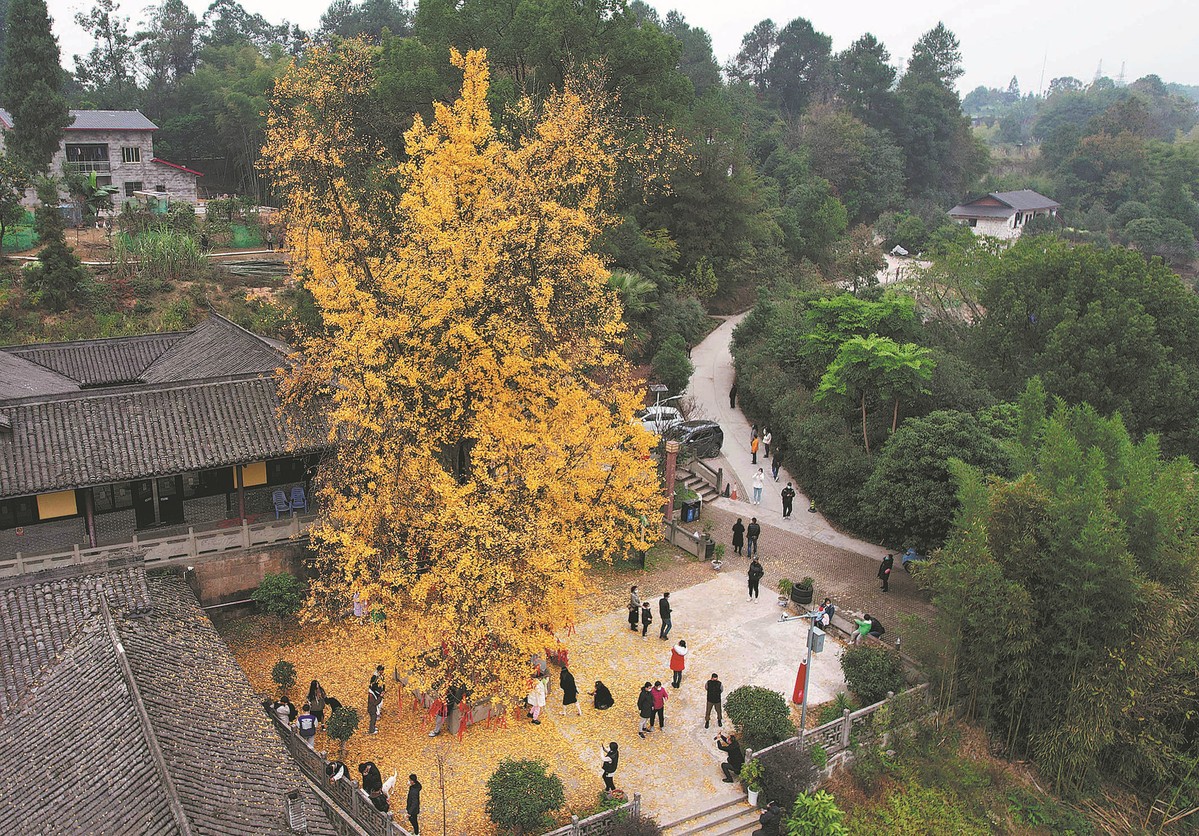Tailored protection to help nature's old-timers live on for generations to come

A 1,200-year-old ginkgo tree draws tourists to Tianxin Temple in Banan district, Chongqing, in December 2022. ZHOU YI/CHINA NEWS SERVICE
In recent years, numerous regions across the country have implemented tailored protection strategies for ancient trees, resulting in the effective protection and rejuvenation of a significant number of valuable ancient and famous trees.
Nonetheless, tree experts have highlighted several shortcomings in these efforts such as issues including "gradual destruction", "micro-destruction" and "protective destruction" affecting these living ecological treasures, as well as critical deficiencies in the systematic and professional aspects of this work that urgently need to be addressed.
The findings of the second national survey of ancient and famous trees conducted by the National Forestry and Grassland Administration in 2022 revealed that China has approximately 5.08 million ancient and famous trees. This total includes around 1.22 million scattered trees and 3.86 million clustered trees within the survey's scope.
According to Xinhua News Agency, instances of "slow destruction" occasionally occur in the country, particularly in rural and remote mountainous areas where the pressure for protection is heightened due to the vast land and sparse population.
In a case handled by a county procuratorate in the western part of the country, 14 individuals were found to have illegally excavated and transplanted over 400 boxwood trees in the Qinling-Daba mountainous area between May 2017 and January 2022. This included 14 ancient trees that were over a hundred years old, with the oldest tree being more than 300 years old.
Ancient trees in densely populated areas are vulnerable to "microdestruction" caused by human activities.
For instance, some ancient trees experience decaying roots, scraped bark, hollow trunks, severe diseases and insect infestations. They may have household garbage accumulated around them, leading to a hostile living environment. Moreover, some trees have wires entangled on their trunks. Some individuals dig holes, remove soil around the trees, burn incense, paper, candles and even dispose of harmful waste liquids — all of which negatively impact the health of the ancient trees.
Some places have implemented extensive restoration of ancient trees or excessively developed tourism around ancient trees, resulting in "protective destruction".
Yang Yongchuan, a professor from the School of Environmental and Ecological Sciences at Chongqing University noted in recent years, some rural areas in the country have utilized ancient and famous trees for tourism development. However, improper practices such as laying bricks or paving cement roads around the trees have hindered their growth by preventing the roots from accessing sufficient nutrients. In other locations, protection measures for ancient and famous trees have been implemented without scientific basis, leading to issues such as the use of inappropriate materials for repairing and filling tree holes, resulting in severe decay of the core wood of the trunk.

Botanical workers water and fertilize nanmu (Phoebe zhennan) trees that are more than 1,500 years old in Youyang, Chongqing, in 2022. QIU HONGBIN/FOR CHINA DAILY
Research and utilization of the ecological value of ancient trees remain inadequate, and there is a lack of thorough exploration and transformation of their historical and cultural value, Yang said.
His research team found that following the announcement of the results of the first national survey of ancient and famous trees in China in 2005, there was an increase in academic papers published from 2010 onward. These papers primarily focused on the quantity of resources, spatial distribution and protection planning, with limited discussion on the ecological characteristics, cultural value and preservation mechanisms of these trees.
While China is among the few countries that have completed a national-level survey of ancient and famous trees, there are still gaps in research. The analysis of the relationship between humans and trees is lacking, and research on the genetic information, growth patterns and relationships with biological groups of ancient trees is still in its early stages. Additionally, the study of tree age, which is crucial for grading ancient trees, has significant gaps, and research on deep-level mechanisms remains insufficient.
The expert suggested refining the legal responsibilities pertaining to the protection and management of ancient and famous trees to establish a sustainable legal protection mechanism. Efforts should also be made to expand the scope and depth of research on ancient trees to provide scientific resources for biodiversity conservation and climate change mitigation. Furthermore, the exploration of the historical and humanistic value of ancient trees should be integrated into the framework of cultural heritage preservation, especially rural cultural development.
Inspiringly, an initiative marking the comprehensive implementation of a judicial guardianship system for millennia-old trees took place in China's southwestern municipality Chongqing recently.
On China's second National Ecology Day on Aug 15, an exclusive appointment ceremony was jointly organized by the Chongqing High People's Court, the Fifth Intermediate People's Court of Chongqing and the Chongqing Forestry Bureau under a 1,200-year-old ancient tree in the city's Wulong district.
Twelve chief judges from the courts of the city's 12 districts, including in Wanzhou, Qianjiang, Fuling and Hechuan districts where 27 millennia-old trees are located, were officially appointed as the city's inaugural group of "Millennium Old Tree Judicial Guardians" to help promote high-quality development of ancient tree protection in the new era.
Zhao Ling, president of the Chongqing Environmental Resources Court under the Fifth Intermediate People's Court of Chongqing said the system employs legal mechanisms and judicial procedures to aid in the preservation and rejuvenation of millennium-old trees, actively leveraging judicial expertise and resources to promote the development of ecological civilization.
Photos
Related Stories
- Better social protection advocated for children
- Cats safely relocated from zoo after monkey abuse sparks public outrage
- Int'l conference on ancient walls, castles protection opens in China
- China's Yunnan sees progress in protecting plant species with extremely small populations
- Global population of crested ibises exceeds 9,000
- New study helps enhance eco-protection of Qilian Mountains
Copyright © 2024 People's Daily Online. All Rights Reserved.









